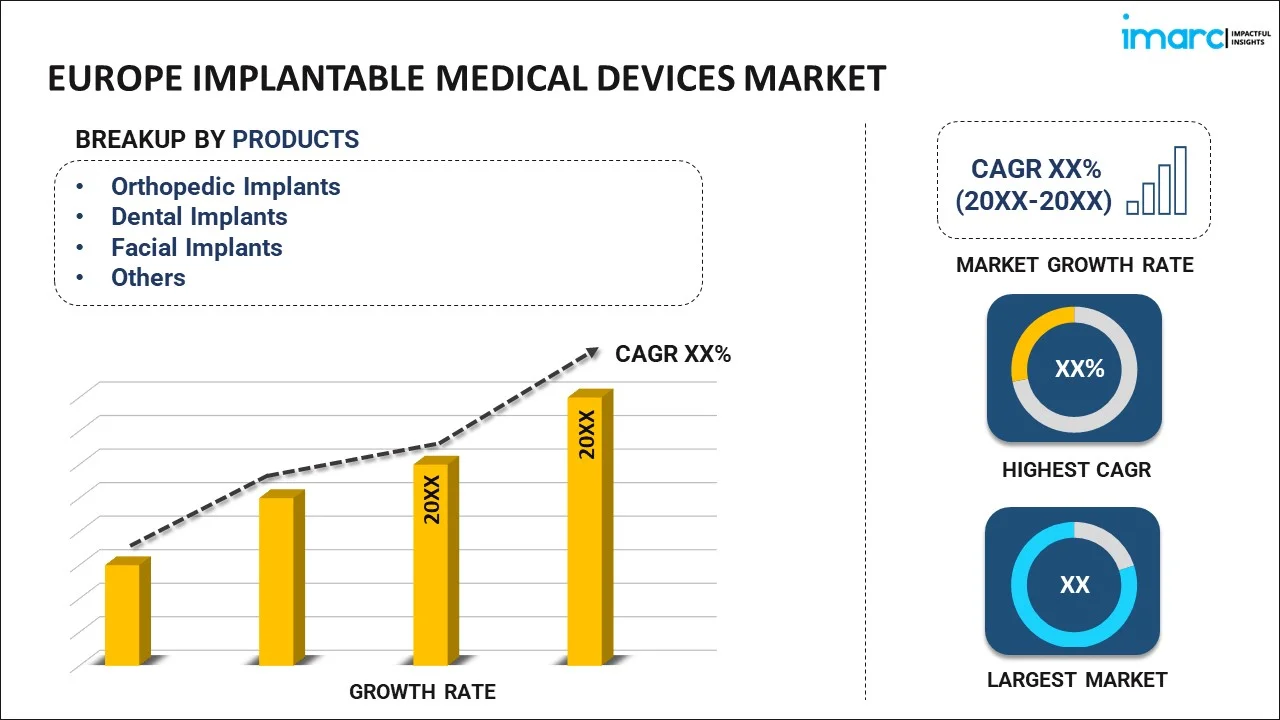
Europe Implantable Medical Devices Market Report by Product (Orthopedic Implants, Dental Implants, Facial Implants, Breast Implants, Cardiovascular Implants, and Others), Material (Polymers, Metals, Ceramics, Biologics), End User (Hospitals, Ambulatory Surgery Centers (ASCs), Clinics), and Country 2025-2033
Market Overview:
The Europe implantable medical devices market size reached USD 37.2 Billion in 2024. Looking forward, IMARC Group expects the market to reach USD 59.1 Billion by 2033, exhibiting a growth rate (CAGR) of 5.30% during 2025-2033.
|
Report Attribute
|
Key Statistics
|
|---|---|
|
Base Year
|
2024 |
|
Forecast Years
|
2025-2033
|
|
Historical Years
|
2019-2024
|
| Market Size in 2024 | USD 37.2 Billion |
| Market Forecast in 2033 | USD 59.1 Billion |
| Market Growth Rate (2025-2033) | 5.30% |
Medical implants are devices intended to deliver medication, replace missing body parts, monitor body functions and support organs and tissues. They are generally made using body tissues, metal, plastic and ceramics. As these devices are biocompatible and resistant against corrosion, they are widely used for orthopedics, pacemakers, cardiovascular stents, defibrillators, neural prosthetics and drug delivery systems. At present, cardiac defibrillators, coronary stents, hip implants, interocular lenses and insulin pumps are some of the widely used implantable medical devices in Europe.
The growing prevalence of chronic diseases, in confluence with the increasing geriatric population, represents one of the key factors bolstering the market growth in Europe. Apart from this, the rising inclination towards improving physical appearances is escalating the demand for cosmetic surgeries, which, in turn, is positively influencing the market growth. Moreover, with developments in microelectronics and biotechnology, several advanced implantable medical devices are available in the market. Furthermore, these devices reduce hospitalization time and enable fast recovery, which is anticipated to strengthen the market growth in the coming years.
Key Market Segmentation:
IMARC Group provides an analysis of the key trends in each segment of the Europe implantable medical devices market report, along with forecasts at the regional and country levels from 2025-2033. Our report has categorized the market based on product, material, and end user.
Breakup by Product:

- Orthopedic Implants
- Dental Implants
- Facial Implants
- Breast Implants
- Cardiovascular Implants
- Others
Breakup by Material:
- Polymers
- Metals
- Ceramics
- Biologics
Breakup by End User:
- Hospitals
- Ambulatory Surgery Centers (ASCs)
- Clinics
Breakup by Country:
- Germany
- France
- United Kingdom
- Italy
- Spain
- Others
Competitive Landscape:
The competitive landscape of the industry has also been examined along with the profiles of the key players.
Report Coverage:
| Report Features | Details |
|---|---|
| Base Year of the Analysis | 2024 |
| Historical Period | 2019-2024 |
| Forecast Period | 2025-2033 |
| Units | Billion USD |
| Segment Coverage | Product, Material, End User, Country |
| Countries Covered | Germany, France, United Kingdom, Italy, Spain, Others |
| Customization Scope | 10% Free Customization |
| Post-Sale Analyst Support | 10-12 Weeks |
| Delivery Format | PDF and Excel through Email (We can also provide the editable version of the report in PPT/Word format on special request) |
Key Questions Answered in This Report:
- How has the Europe implantable medical devices market performed so far and how will it perform in the coming years?
- What has been the impact of COVID-19 on the Europe implantable medical devices market?
- What are the key regional markets?
- What is the breakup of the market based on the product?
- What is the breakup of the market based on the material?
- What is the breakup of the market based on the end user?
- What are the various stages in the value chain of the industry?
- What are the key driving factors and challenges in the industry?
- What is the structure of the Europe implantable medical devices market and who are the key players?
- What is the degree of competition in the industry?
Need more help?
- Speak to our experienced analysts for insights on the current market scenarios.
- Include additional segments and countries to customize the report as per your requirement.
- Gain an unparalleled competitive advantage in your domain by understanding how to utilize the report and positively impacting your operations and revenue.
- For further assistance, please connect with our analysts.
 Inquire Before Buying
Inquire Before Buying
 Speak to an Analyst
Speak to an Analyst
 Request Brochure
Request Brochure
 Request Customization
Request Customization




.webp)




.webp)












